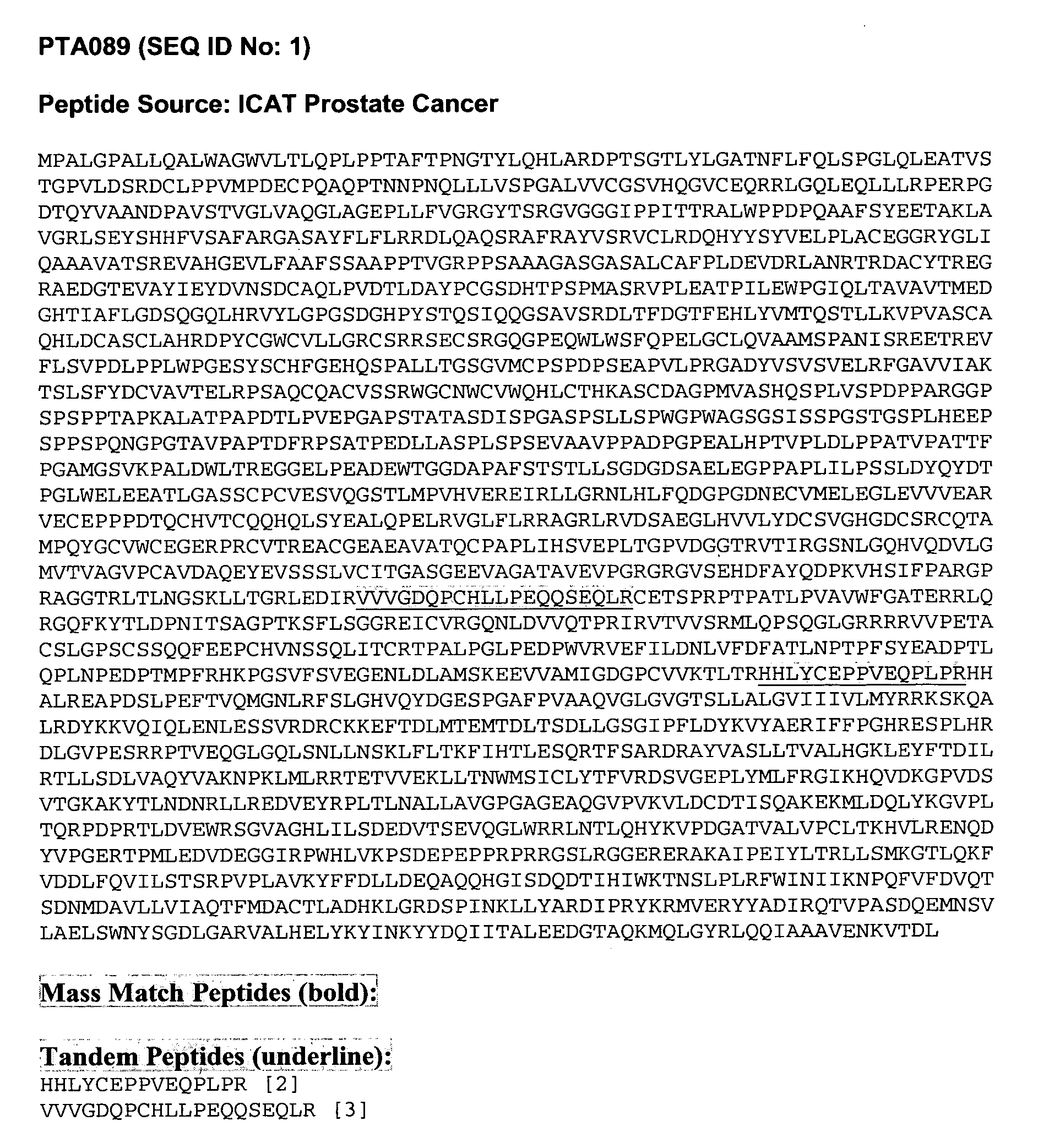Pta089 protein
- Summary
- Abstract
- Description
- Claims
- Application Information
AI Technical Summary
Benefits of technology
Problems solved by technology
Method used
Image
Examples
example 1
Identification of Membrane Proteins Expressed in Prostate Cancer Tissue Samples
[0374]Using the following Reference Protocol, membrane proteins extracted from prostate cancer tissue samples were analysed using Isotope-Coded Affinity Tags (ICAT).
1.1 Materials and Methods
1.1.1—Preparation of Membrane Fractions
[0375]The cells recovered from a prostate cancer were lysed and submitted to centrifugation at 1000 G. The supernatant was taken, and it was subsequently centrifuged at 3000 G. Once again, the supernatant was taken, and it was then centrifuged at 100 000 G.
[0376]The resulting pellets were dissolved by boiling in labeling buffer (50 mM Tris-HCl pH 8.3, 5 mM EDTA, 0.5% SDS), and the protein concentration was measured.
[0377]A Western blot was used to verify membrane protein markers.
1.1.2—Synthesis of ICAT Reagents
[0378]The ICAT reagents used were synthesized with the following isotopically different substrates: 4,7,10-trioxa-1,13-tridecanediamine (A) (Aldrich, Milwaukee, Wis.) and 2,...
example 2
Immunohistochemistry Using Antibody to PTA089
[0396]Using the following Reference Protocol, immunohistochemistry was performed on FFPE tumor and normal tissues using two rabbit polyclonal antibodies to PTA089 (Abcam, ab39717 and ab41064).
2.1 Materials and Methods
[0397]Anti-rabbit EnVision plus kit (K4010) was from DAKO, CA, USA.
EX-De-Wax was from BioGenex, CA, USA.
Tissue sections and arrays were from Biomax, MD, USA.
2.1.1—Deparaffinisation and Rehydration
[0398]Slides were heated for 2 h at 60° C. in 50 ml Falcons in a water bath with no buffer. Each Falcon had one slide or two slides back-to back with long gel loading tip between them to prevent slides from sticking to each other. Slides were deparaffinised in EZ-DeWax for 5 min in black slide rack, then rinsed well with the same DeWax solution using 1 ml pipette, then washed with water from the wash bottle. Slides were placed in a coplin jar filled with water; the water was changed a couple of times.
2.1.2—Antigen Retrieval
[0399]Wate...
example 3
RNA Profiling of PTA089
[0409]Using the following Reference Protocol performed by Asterand, gene expression data for PTA089 was obtained using quantitative Real Time-PCR on 72 different tissue types.
3.1 Materials and Methods
[0410]Gene expression data for PTA089 was obtained using Real Time-PCR on 72 different tissue types. Each tissue type was obtained from three different human donors (FIGS. 2a-2c). The oligonucleotide primer set was chosen to represent PTA089 (SEQ ID No: 1).
[0411]Asterand have generated a global standard curve (GSC) which can be applied to measurements of expression of all genes. In order to quantify the number of copies of mRNA in the assay it is necessary to correlate the number of PCR cycles required to reach threshold with the starting copy number. This has been done for 81 genes. This is particularly useful in situations where the primer-probe sets are positioned such that they span an intron and therefore fail to amplify from genomic DNA. In these circumstanc...
PUM
| Property | Measurement | Unit |
|---|---|---|
| Fraction | aaaaa | aaaaa |
| Fraction | aaaaa | aaaaa |
| Fraction | aaaaa | aaaaa |
Abstract
Description
Claims
Application Information
 Login to View More
Login to View More - R&D
- Intellectual Property
- Life Sciences
- Materials
- Tech Scout
- Unparalleled Data Quality
- Higher Quality Content
- 60% Fewer Hallucinations
Browse by: Latest US Patents, China's latest patents, Technical Efficacy Thesaurus, Application Domain, Technology Topic, Popular Technical Reports.
© 2025 PatSnap. All rights reserved.Legal|Privacy policy|Modern Slavery Act Transparency Statement|Sitemap|About US| Contact US: help@patsnap.com



